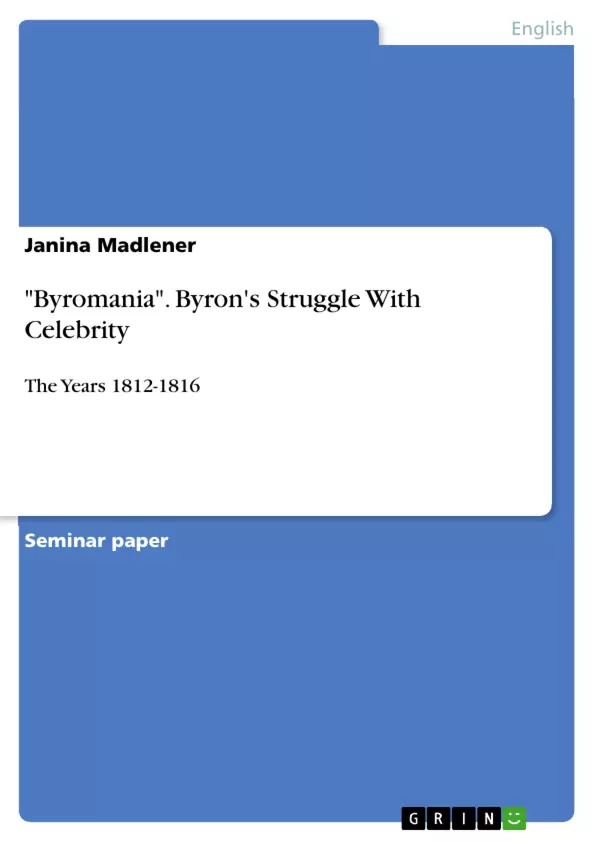When George Gordon Byron, better known as Lord Byron, sails from Dover to Ostend on 25 April 1816, he leaves his homeland forever. When he departed England for the first time in his youth, he was an unknown young poet seeking adventures in Albania, Turkey and Greece. Now, he is – after Wellington and Prince Regent – the best- known man in England and flees the outraged British public and into exile. In the time between his first return and final departure from England, he achieved previously unheard levels of poetic fame and an interest in one ́s personality, which is why many critics regard him as “the first truly modern literary celebrity”. The question that arises is, what it means to be a celebrity and why Byron nevertheless needs to leave England.
The phenomenon of celebrity has become a defining and omnipresent characteristic of our mediatized societies, but only for the last years scholars have begun to see celebrity ́s roots in 19th century Romanticism.
This paper will focus on the time between 1812 and 1816 and will investigate the early beginnings of celebrity based on the life of Lord Byron: How far is celebrity different from fame? How does Byron become a celebrity and what effects does it have on his life? Claiming that Byron himself purposefully supports the interest in him as a person, I will furthermore show that slowly celebrity becomes a prison for him and forces him leave England.
Inhaltsverzeichnis (Table of Contents)
- INTRODUCTION
- I. CELEBRITY CULTURE
- I.1 The Study of Celebrity Culture
- I.2 Defining the Term ‘Celebrity’
- II. BYRON'S EARLY DAYS OF CELEBRITY
- II.1 BYRON'S ORIGINS
- II.2 ‘I AWOKE ONE MORNING AND FOUND MYSELF FAMOUS’
- II.3 NOURISHING AN INTEREST IN HIS PERSONA - THE ‘BYRONIC HERO’ AND 'BYROMANIA'
- II.4 THE PHENOMENON OF 'BYROMANIA'
- II.5 A LIFE OF SCANDAL
- III. THE EFFECTS OF CELEBRITY ON BYRON
- III.1 The Effects of ‘BYROMANIA’
- III.2 HIS MARITAL FAILURE TURNING HIM TO A 'SOCIAL OUTCAST'
- III.3 ADJUSTING THE DEFINITION OF ‘CELEBRITY’
- CONCLUSION
Zielsetzung und Themenschwerpunkte (Objectives and Key Themes)
This paper examines the early beginnings of celebrity culture in the 19th century, focusing on the life and career of Lord Byron. It explores how celebrity differs from fame, investigates the factors that contributed to Byron's rise to fame, and analyzes the impact of celebrity on his life.- The distinction between celebrity and fame
- The origins and development of celebrity culture in the early 19th century
- Lord Byron's role in shaping the concept of celebrity
- The effects of celebrity on Byron's personal life and career
- The evolving definition of 'celebrity' and its connection to scandal
Zusammenfassung der Kapitel (Chapter Summaries)
- INTRODUCTION: This introductory chapter establishes the context of the paper by outlining the phenomenon of celebrity culture and its origins in 19th century Romanticism. It highlights Byron's unique position as a literary celebrity and his eventual exile from England.
- I. CELEBRITY CULTURE: This section explores the history of the study of celebrity culture and examines the evolution of the term 'celebrity'. It differentiates between fame and celebrity, highlighting the focus on the individual's life rather than their posthumous reputation.
- II. BYRON'S EARLY DAYS OF CELEBRITY: This section focuses on Byron's early life, his upbringing, and his longing for acceptance and freedom. It highlights his rapid rise to fame, marked by his famous statement "I awoke one morning and found myself famous." The chapter then delves into the creation of the 'Byronic hero' and the phenomenon of "Byromania," examining how Byron cultivated and supported his own celebrity.
- III. THE EFFECTS OF CELEBRITY ON BYRON: This section examines the negative consequences of Byron's celebrity, particularly his marital difficulties with Annabella Milbanke and the subsequent public scrutiny and rumors surrounding him. It explores how Byron's experiences contributed to a nuanced understanding of 'celebrity' as a complex and contradictory phenomenon.
Schlüsselwörter (Keywords)
This paper examines the emergence of celebrity culture in the early 19th century, focusing on the life and work of Lord Byron. Key terms include: celebrity, fame, Romanticism, Byronism, Byronic hero, Byromania, scandal, public image, persona, notoriety, and the social and cultural impact of celebrity.- Quote paper
- Janina Madlener (Author), 2015, "Byromania". Byron's Struggle With Celebrity, Munich, GRIN Verlag, https://www.grin.com/document/415665



